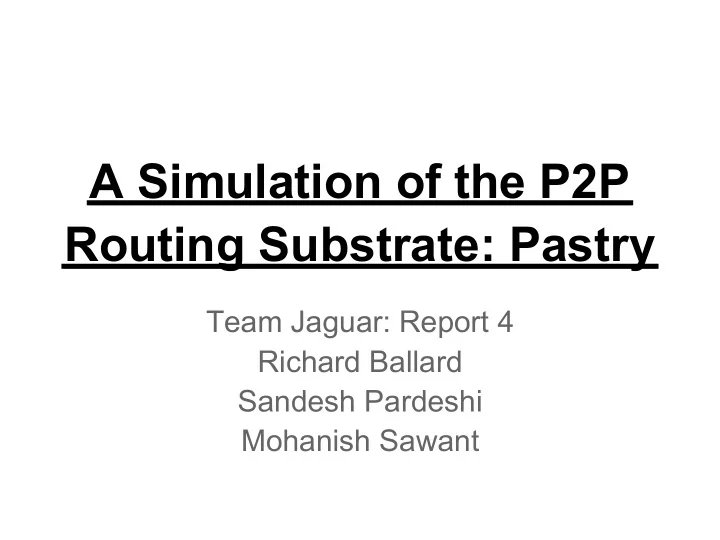

A Simulation of the P2P Routing Substrate: Pastry Team Jaguar: Report 4 Richard Ballard Sandesh Pardeshi Mohanish Sawant
Agenda ● Recap ● Hypothesis ● Software Design ● Demo ● Data ● Analysis ● Future Work ● Lessons Learned ● Questions
Recap: Pastry ● P2P substrate ● Allows for efficient routing in an unpredictable environment ● Each node maintains 2 tables: leaf set and routing table ● Routing is based on proximity (leaf set) and increasing prefix match (routing table)
Recap ● Routing in Pastry Source: 63AB ○ Destination: EB3E ○ Leaf Set ○ Routing Table ○
Hypothesis ● The pastry algorithm will perform routing within log 2^m N hops Where, N: Number of nodes. m: Configuration parameter, for Pastry, in our case it is 4 (Configuration Parameter alters the Node ID’s, 4 means NodeID’s are Hexadecimal)
Software Design ● Pastry.java and Sim.java ● Pastry.java uses a PRNG to populate an array of n random BigIntegers node IDs in the range 0 to 2 128 -1 ● Tables for the leaf set and routing table are not created
Software Design ● Pastry class ○ prefixMatch() ○ leafSet() ○ route() ○ popNodes() ● Sim class ○ Linear Regression ○ plot the data ○ log16()
Demo
Data
Data
Data analysis ● Our p-values support our hypothesis. (They are greater than the threshold of .05) ● The Model Parameters a & b show that our model is a good fit for the data ● Analysis on other datasets show similar results ● Thus proving our hypothesis to be True
Future Work ● Test the system under dynamic conditions with some random probability of node failure ● Improve speed of the prefix match function ● Run more trials
Lessons learned ● The architecture and the routing of the Pastry protocol ● How to design and develop simulation software ● How to use the test cases to prove/disprove the hypothesis
References [1] Kong, J.S.; Bridgewater, J.S.A.; Roychowdhury, V.P.; , "A General Framework for Scalability and Performance Analysis of DHT Routing Systems," Dependable Systems and Networks, 2006. DSN 2006. International Conference on , vol., no., pp.343-354, 25-28 June 2006 doi: 10.1109/DSN.2006.4 URL:http://ieeexplore.ieee.org.ezproxy.rit.edu/stamp/stamp.jsp?tp=&arnumber=1633523&isnumber=34248 [2] Castro, M.; Druschel, P.; Kermarrec, A.-M.; Rowstron, A.I.T.; , "Scribe: a large-scale and decentralized application-level multicast infrastructure," Selected Areas in Communications, IEEE Journal on , vol.20, no.8, pp. 1489- 1499, Oct 2002 doi: 10.1109/JSAC.2002.803069 URL:http://ieeexplore.ieee.org.ezproxy.rit.edu/stamp/stamp.jsp?tp=&arnumber=1038579&isnumber=22260 [3] Khan, S.; Gani, A.; Sreekandath, M.; , "The routing performance of logarithmic-hop structured P2P overlay," Open Systems (ICOS), 2011 IEEE Conference on , vol., no., pp.202-207, 25-28 Sept. 2011 doi: 10.1109/ICOS.2011.6079289 URL:http://ieeexplore.ieee.org.ezproxy.rit.edu/stamp/stamp.jsp?tp=&arnumber=6079289&isnumber=6079225 [4] Antony I. T. Rowstron and Peter Druschel. 2001. Pastry: Scalable, Decentralized Object Location, and Routing for Large-Scale Peer-to-Peer Systems. In Proceedings of the IFIP/ACM International Conference on Distributed Systems Platforms Heidelberg (Middleware '01), Rachid Guerraoui (Ed.). Springer- Verlag, London, UK, 329-350. URL:http://dl.acm.org/citation.cfm?id=697650 [5] Parallel Java Library: URL:http://www.cs.rit.edu/~ark/pj.shtml. [6] Computer Science Course Library: URL: http://www.cs.rit.edu/~ark/cscl.shtml. [7] The book Simulation Simplified, version 23-Aug-2011 by Prof. Alan Kaminsky. URL: http://www.cs.rit.edu/~ark/ss/ss20110823.pdf
Questions?
Recommend
More recommend